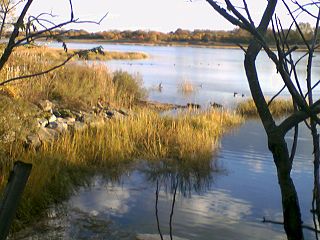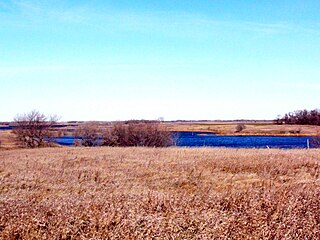
The Environmental Protection Agency (EPA) is an independent agency of the United States government tasked with environmental protection matters. President Richard Nixon proposed the establishment of EPA on July 9, 1970; it began operation on December 2, 1970, after Nixon signed an executive order. The order establishing the EPA was ratified by committee hearings in the House and Senate.

The Clean Water Act (CWA) is the primary federal law in the United States governing water pollution. Its objective is to restore and maintain the chemical, physical, and biological integrity of the nation's waters; recognizing the responsibilities of the states in addressing pollution and providing assistance to states to do so, including funding for publicly owned treatment works for the improvement of wastewater treatment; and maintaining the integrity of wetlands.
Environmental mitigation refers to the process by which measures to avoid, minimise, or compensate for adverse impacts on the environment are applied. In the context of planning processes like Environmental Impact Assessments, this process is often guided by applying conceptual frameworks like the "mitigation hierarchy" or "mitigation sequence". This generally includes the steps avoid, reduce, restore, and offset. In some countries, environmental mitigation measures, including biodiversity offsetting, may be required by law.

Mitigation banking is a market-based system that involves restoration, creation, or enhancement of wetlands to compensate for unavoidable impacts to a wetland in another location. It involves a system of mitigation banks, sites where projects to restore, create, or enhance wetlands can be carried out in advance of impacts. The outcomes of these projects are valued through the creation of compensatory mitigation credits that can be purchased from mitigation banks to offset the negative impacts of developments or agriculture expansion on wetlands and aquatic habitats. This process is generally conducted with the aim of achieving no net loss of function and value for specific aquatic habitats, such as in terms of the biodiversity or ecosystem services provided by a wetland.

Wetlands of the United States are defined by the United States Army Corps of Engineers and the United States Environmental Protection Agency as "those areas that are inundated or saturated by surface or ground water at a frequency and duration sufficient to support, and that under normal circumstances do support, a prevalence of vegetations typically adapted for life in saturated soils. Wetlands generally include swamps, marshes, bogs, and similar areas." Wetlands can be valued in terms of their contributions to ecological, economic and social systems. Wetlands service these systems through multiple processes including water filtration, water storage and biological productivity. They also contribute the functions of flood control, providing a nutrient sink, groundwater recharge and habitat.
To protect the environment from the adverse effects of pollution, many nations worldwide have enacted legislation to regulate various types of pollution as well as to mitigate the adverse effects of pollution. At the local level, regulation usually is supervised by environmental agencies or the broader public health system. Different jurisdictions often have different levels regulation and policy choices about pollution. Historically, polluters will lobby governments in less economically developed areas or countries to maintain lax regulation in order to protect industrialisation at the cost of human and environmental health.

The Clean Water State Revolving Fund (CWSRF) is a self-perpetuating loan assistance authority for water quality improvement projects in the United States. The fund is administered by the Environmental Protection Agency and state agencies. The CWSRF, which replaced the Clean Water Act Construction Grants program, provides loans for the construction of municipal wastewater facilities and implementation of nonpoint source pollution control and estuary protection projects. Congress established the fund in the Water Quality Act of 1987. Since inception, cumulative assistance has surpassed 153.6 billion dollars as of 2021, and is continuing to grow through interest earnings, principal repayments, and leveraging.
Biodiversity banking, also known as biodiversity trading, conservation banking, mitigation banking, habitat banking, compensatory habitat, or set-asides, describes a market-based framework for biodiversity offsetting where offsets can be traded in the form of credits to offset negative environmental impacts of development projects or activities. This involves biodiversity banks, areas with biodiversity value. On the site of a biodiversity bank, conservation activities may be carried out to preserve, restore, enhance, or conserve biodiversity. The outcomes of projects carried out at biodiversity banks are valued in the form of credits, which can be purchased as a way to offset unavoidable adverse environmental impacts, often with the aim of achieving no net loss of biodiversity.
Solid Waste Agency of Northern Cook County (SWANCC) v. U.S. Army Corps of Engineers, 531 U.S. 159 (2001), was a decision by the US Supreme Court that interpreted a provision of the Clean Water Act. Section 404 of the Act requires permits for the discharge of dredged or fill materials into "navigable waters," which is defined by the Act as "waters of the United States." That provision was the basis for the federal wetlands-permitting program.

Nutrient pollution, a form of water pollution, refers to contamination by excessive inputs of nutrients. It is a primary cause of eutrophication of surface waters, in which excess nutrients, usually nitrogen or phosphorus, stimulate algal growth. Sources of nutrient pollution include surface runoff from farm fields and pastures, discharges from septic tanks and feedlots, and emissions from combustion. Raw sewage is a large contributor to cultural eutrophication since sewage is high in nutrients. Releasing raw sewage into a large water body is referred to as sewage dumping, and still occurs all over the world. Excess reactive nitrogen compounds in the environment are associated with many large-scale environmental concerns. These include eutrophication of surface waters, harmful algal blooms, hypoxia, acid rain, nitrogen saturation in forests, and climate change.

Water quality laws govern the protection of water resources for human health and the environment. Water quality laws are legal standards or requirements governing water quality, that is, the concentrations of water pollutants in some regulated volume of water. Such standards are generally expressed as levels of a specific water pollutants that are deemed acceptable in the water volume, and are generally designed relative to the water's intended use - whether for human consumption, industrial or domestic use, recreation, or as aquatic habitat. Additionally, these laws provide regulations on the alteration of the chemical, physical, radiological, and biological characteristics of water resources. Regulatory efforts may include identifying and categorizing water pollutants, dictating acceptable pollutant concentrations in water resources, and limiting pollutant discharges from effluent sources. Regulatory areas include sewage treatment and disposal, industrial and agricultural waste water management, and control of surface runoff from construction sites and urban environments. Water quality laws provides the foundation for regulations in water standards, monitoring, required inspections and permits, and enforcement. These laws may be modified to meet current needs and priorities.

Nonpoint source (NPS) water pollution regulations are environmental regulations that restrict or limit water pollution from diffuse or nonpoint effluent sources such as polluted runoff from agricultural areas in a river catchments or wind-borne debris blowing out to sea. In the United States, governments have taken a number of legal and regulatory approaches to controlling NPS effluent. Nonpoint water pollution sources include, for example, leakage from underground storage tanks, storm water runoff, atmospheric deposition of contaminants, and golf course, agricultural, and forestry runoff.

Over the past 200 years, the United States has lost more than 50% of its wetlands. And even with the current focus on wetland conservation, the US is losing about 60,000 acres (240 km2) of wetlands per year. However, from 1998 to 2004 the United States managed a net gain of 191,750 acres (776.0 km2) of wetlands . The past several decades have seen an increasing number of laws and regulations regarding wetlands, their surroundings, and their inhabitants, creating protections through several different outlets. Some of the most important have been and are the Migratory Bird Act, Swampbuster, and the Clean Water Act.

Biodiversity offsetting is a system used predominantly by planning authorities and developers to fully compensate for biodiversity impacts associated with economic development, through the planning process. In some circumstances, biodiversity offsets are designed to result in an overall biodiversity gain. Offsetting is generally considered the final stage in a mitigation hierarchy, whereby predicted biodiversity impacts must first be avoided, minimised and reversed by developers, before any remaining impacts are offset. The mitigation hierarchy serves to meet the environmental policy principle of "No Net Loss" of biodiversity alongside development.

The Waters of the United States Regulatory Overreach Protection Act of 2014 is a bill that would prohibit the Environmental Protection Agency (EPA) and the U.S. Army Corps of Engineers (Corps) from implementing or enforcing certain proposed regulations regarding the use of the nation’s waters and wetlands.

The Clean Water Rule is a 2015 regulation published by the U.S. Environmental Protection Agency (EPA) and the United States Army Corps of Engineers (USACE) to clarify water resource management in the United States under a provision of the Clean Water Act of 1972. The regulation defined the scope of federal water protection in a more consistent manner, particularly over streams and wetlands which have a significant hydrological and ecological connection to traditional navigable waters, interstate waters, and territorial seas. It is also referred to as the Waters of the United States (WOTUS) rule, which defines all bodies of water that fall under U.S. federal jurisdiction. The rule was published in response to concerns about lack of clarity over the act's scope from legislators at multiple levels, industry members, researchers and other science professionals, activists, and citizens.

Conservation banking is an environmental market-based method designed to offset adverse effects, generally, to species of concern, are threatened, or endangered and protected under the United States Endangered Species Act (ESA) through the creation of conservation banks. Conservation banking can be viewed as a method of mitigation that allows permitting agencies to target various natural resources typically of value or concern, and it is generally contemplated as a protection technique to be implemented before the valued resource or species will need to be mitigated. The ESA prohibits the "taking" of fish and wildlife species which are officially listed as endangered or threatened in their populations. However, under section 7(a)(2) for Federal Agencies, and under section 10(a) for private parties, a take may be permissible for unavoidable impacts if there are conservation mitigation measures for the affected species or habitat. Purchasing “credits” through a conservation bank is one such mitigation measure to remedy the loss.
The Freshwater Wetlands Protection Act was passed by the New Jersey Legislature on July 1, 1987, to "preserve the purity and integrity of freshwater wetlands from random, unnecessary or undesirable alteration or disturbance." This statute extended state and federal protection of waterways. Prior to this act, only coastal and navigable waters were protected. The act extended protection to inland waterways and freshwater wetlands, which serve to protect water quality, provide flood protection, and provide habitat for wildlife.
Sackett v. Environmental Protection Agency, 598 U.S. 651 (2023), also known as Sackett II, was a United States Supreme Court case related to the scope of the Clean Water Act.

Canadian wetlands account for approximately one quarter of the world's total wetlands and is ranked with the highest surface area of wetlands on the Ramsar Conventions List of Wetlands of International Importance. Canada holds 37 designated areas of International Importance which equates to approximately 13,086,767 hectares of land.











